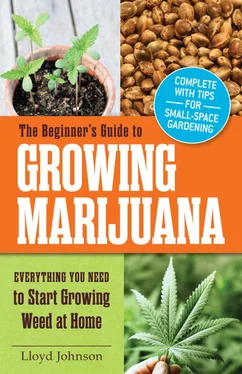Also note that cuttings that are in the process of rooting will show some yellowing at approximately one week, especially on the lower leaves. This is normal and will rectify itself once the root system has developed.
There can be a number of reasons for stunted plant growth: poor soil, poor drainage, lack of nutrients, lack of light, temperatures too hot or too cold, and excessive humidity or dryness. Other reasons may be fungal root infections or pest infestations.
Poor performance by seedlings is an indication of damping off; you have used contaminated soil or the growing medium is too wet. Gently dig up the most pitiful specimen and inspect its root; damping off thins the plump white root in sections. Generally you will have to start more seed, using clean soil and sterilized pots. Make sure not to overwater young seedlings and inadvertently create a welcoming environment for damping off. Provide good air circulation and ventilation at all times.
Seedlings will also grow slowly if their environment is too cold. If you grow outdoors, make certain you are not trying to get too far ahead of your local growing season. If you want to get seedlings started early, you must provide enough light and warmth indoors, and plan for a period of hardening off when you transfer the plants outdoors.
Cannabis growth is very rapid during the vegetative phase. If your plants are not transplanted to larger containers or fed for growth in smaller containers, they will eventually run out of room and food.
Keep It Simple
As always, a quick check of pH and N-P-K levels will give you a great deal of information, and probably point you to the correction needed.
Next to unhealthy pH levels, bad drainage is probably the most common cause of stunted growth in cannabis. Cannabis hates soggy soil, and responds by sulking and growing slowly. Conversely, cannabis also has big water requirements and drinks deeply. If you consistently forget to water your plants, expect poor growth performance.
If you are growing outdoors in the ground, and just one or two plants suddenly slow dramatically, look carefully around the grow site for telltale gopher mounds. Gophers throw up soil from their tunnels and can appear quite suddenly in outdoor gardens, partly because your good soil is full of earthworms and other food they find tasty. You do not have to see the gophers, and probably will not. The mounds will let you know they have invaded.
Unfortunately, a gopher will power right through a cannabis root ball, severely impeding the plant’s support system. If you plant directly into the ground, you should line the planting holes with chicken wire. Once you realize you have gophers and your plants are already in the ground, there is no moving the plants without causing great stress and shock to the plants.
Green Leaves but No Flowers
This could be caused by a number of reasons. The indoor grower must trigger flowering by cutting the light cycle to twelve hours. If the plants still make no move to begin flowering, check that the dark phase is truly dark. Light leakage can confuse plants. The outdoor grower must wait until the sun’s cycle reaches this critical trigger point for cannabis. Make note of how many hours of sun the plants still receive, and check for light sources outdoors that may be disturbing the plants. Certain genotypes will flower later than others. Many outdoor cannabis breeders place a lot of emphasis on strains that flower early, particularly in areas that typically have heavy fall rains.
Check the N-P-K ratio of your plant’s food. You may be feeding too much nitrogen during the flowering phase. The plant needs lots of nitrogen, approximately 10-7-8 during the vegetative phase, but continuing to feed too much will delay flowering after the light changes. Flush the soil with plain water, and feed flowering plants more phosphorus, using a 4-8-8 ratio. Plants should be allowed to become nitrogen deficient late in flowering; some growers say this improves flavor.
Sometimes plants become overheated, or their soil has dried out. The obvious solution is to give them water, and water deeply so the plant gets a good drink. The plants should become turgid again very quickly.
Sometimes, however, the problem can be damage to roots or salt buildup in soil. Not much can be done after roots are damaged, but flushing the soil with clean water can help leach out excess salts.
We discussed mold in more detail in Chapter 12, but as you troubleshoot, keep in mind that different types of molds and mildews attack cannabis at all phases of growth and production. If unidentified and left unchecked, eventually you will lose a significant portion of, or even all, your harvest. Generally, when cannabis growers say they have mold, they mean they have an outbreak of the dreaded botrytis.
Botrytis, or gray mold, is the most destructive to cannabis. It requires high humidity conditions (50 percent or higher) and debris from old leaves or bruised, broken plant parts to provide a food base before it invades the plant. Rainy conditions outdoors, high humidity indoors, and the natural leaf drop near harvest time can provide perfect conditions for a botrytis outbreak. To prevent infection, remove dead leaves or damaged tissue from the plants, and keep the garden area clean as well. If you break a plant accidentally or take cuttings for propagation, repair immediately. Once you spot botrytis, remove any infected portion immediately, adjust humidity levels, and monitor each plant on a daily basis for continued outbreaks.
Once the plants are hanging, make certain to check humidity levels and to provide excellent air circulation. Examine the plants carefully twice a day and remove any spots of mold as soon as they appear. Some growers take a lighter or barbecue starter and burn the area where they have removed botrytis. This may have the effect of completely drying out the wet, mold-infected area and preventing further spread on the plant.
Spider mites reproduce rapidly in the hot conditions of a cannabis grow room. Plants under water stress are highly susceptible, so make certain to water on schedule.
Spider mites are so tiny that an initial infestation is easy to miss until you start seeing damage to the plants. Examine your plants closely with a handheld lens with at least ten times magnification. Spider mite eggs are usually laid near the veins of leaves during the growing season; they look like little drops of water until they become cream colored just before hatching. Check all over, but particularly on the undersides of leaves for old hatched eggshells as well as the adult spider mites, their eggs, and the distinctive spider mite webbing.
Adult spider mites have eight legs and an oval body, with two red eyespots near the head end of the body. The immature spider mites resemble the adults, except the newly hatched larvae have only six legs.
Spider mite colonies can contain hundreds of individual mites and produce very distinctive silk webbing on infested leaves. The presence of this webbing is the easiest way to distinguish them from other types of mites. Lightly misting your plants before inspecting them will make the webs much easier to see. If you spot mites, act quickly and bathe the plants with an organic insecticidal soap, or use organic neem oil. Make certain to get the undersides of the leaves and the entire plant; leaving any spider mites behind will just start the cycle all over again.
Keep It Simple
Always check new plants from outside sources very carefully for spider mites. If the plants were started indoors, be especially wary. Keep the new additions isolated from your other plants until you are certain they are not carrying spider mites. This little bit of extra care will pay off over and over.
Читать дальше












